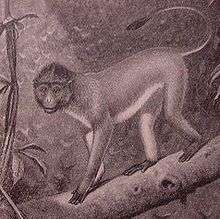Surili
| Surili[1] | |
|---|---|
 | |
| Javan surili | |
| Scientific classification | |
| Kingdom: | Animalia |
| Phylum: | Chordata |
| Class: | Mammalia |
| Order: | Primates |
| Suborder: | Haplorhini |
| Infraorder: | Simiiformes |
| Family: | Cercopithecidae |
| Subfamily: | Colobinae |
| Genus: | Presbytis Eschscholtz, 1821 |
| Type species | |
| Presbytis mitrata | |
| Species | |
|
11, see text | |
The surilis are a group of Old World monkeys and make up the entirety of the genus Presbytis. They live in the Thai-Malay Peninsula, on Sumatra, Borneo, Java and smaller nearby islands.[1]
Surilis are rather small, slim built primates. Their fur at the top is brown, grey, black or orange, and at the lower surface whitish or greyish, sometimes also orange, with some species having fur designs at the head or at the hips.[2][3] Their German name of Mützenlanguren ("capped langurs") comes from the hair on their head, which forms a tuft. They differ from the other langurs by characteristics in the shape of their head (particularly the poorly developed or absent brow ridges, and the prominent nasal bones),[2] in the teeth and by the size of their small thumbs. Surilis range in adult length from 40 to 60 cm (with a 50 to 85 cm long tail) and a weight of 5 to 8 kg.[2]
Diurnal forest dwellers, they spend nearly their entire life in the trees. They live in groups of up to 21 animals (average 10 or fewer animals in most species) consisting of a male, several females, and their young.[3] A few species have been observed in monogamous pairings (particularly the Mentawai langur),[3] although this might be a reaction to the decrease of their habitat. Lone males and all-male groups have also been reported.[2] The groups are hierarchically developed, with intergroup communication that is both vocal and postural.
The surilis' diet consists of leaves, fruits, and seeds.[3]
Gestation time is five to six months, and births are typically of single young. Newborn animals are white colored and have a black strip at the back, although some have a cross-shaped mark. By one year the young are weaned and at an age of four to five years they are fully mature. The typical life expectancy in the wild remains poorly known for most species, but captive Sumatran surilis have lived for more than 18 years.[2]
Several species in this genus are restricted to regions with extensive habitat destruction, and are also threatened by hunting. Consequently, 8 of the 11 species are rated as vulnerable or worse by IUCN,[4] and the Sarawak surili has been referred to as "one of the rarest primates in the world."[5] Recently a subspecies of Hose's langur called Miller's grizzled langur, thought to be extinct, was rediscovered in the Wehea Forest on the eastern tip of Borneo island,[6] though it remains one of the world's most endangered primates.[7]
Taxonomy
Two additional genera, Trachypithecus and Semnopithecus, were formerly considered subgenera of Presbytis.[1] The species-level taxonomy of Presbytis is complex, and significant changes have been proposed for several in recent years.[1]
- Genus Presbytis [1]
- Sumatran surili, Presbytis melalophos
- Yellow-handed mitered surili, Presbytis melalophos melalophos
- Presbytis melalophos bicolor,
- Presbytis melalophos sumatrana,
- Presbytis melalophos mitrata,
- Banded surili, Presbytis femoralis
- Raffles' banded surili, Presbytis femoralis femoralis
- Robinson's banded surili, Presbytis femoralis robinsoni
- East Sumatran banded surili, Presbytis femoralis percura
- Sarawak surili, Presbytis chrysomelas
- Bornean banded surili, Presbytis chrysomelas chrysomelas
- Tricolored surili, Presbytis chrysomelas cruciger
- White-thighed surili, Presbytis siamensis
- Malayan white-thighed surili, Presbytis siamensis siamensis
- Presbytis siamensis rhionis
- Presbytis siamensis cana
- Presbytis siamensis paenulata
- White-fronted surili, Presbytis frontata
- Javan surili, Presbytis comata
- Grizzled leaf monkey, Presbytis comata comata
- Javan fuscous langur, Presbytis comata fredericae
- Thomas's langur, Presbytis thomasi
- Hose's langur, Presbytis hosei
- Hose's grizzled langur, Presbytis hosei hosei
- Everett's grizzled langur, Presbytis hosei everetti
- Saban grizzled langur, Presbytis hosei sabana
- Miller's grizzled langur, Presbytis hosei canicrus
- Maroon leaf monkey, Presbytis rubicunda
- Muller's maroon langur, Presbytis rubicunda rubicunda
- Presbytis rubicunda rubida
- Presbytis rubicunda ignita
- Davis's maroon langur, Presbytis rubicunda chrysea
- Karimata Island maroon langur, Presbytis rubicunda carimatae
- Mentawai langur or joja, Presbytis potenziani
- Golden-bellied Mentawai langur, Presbytis potenziani potenziani
- Sombre-bellied Mentawai langur, Presbytis potenziani siberu
- Natuna Island surili, Presbytis natunae
- Sumatran surili, Presbytis melalophos
References
- 1 2 3 4 5 Groves, C.P. (2005). Wilson, D.E.; Reeder, D.M., eds. Mammal Species of the World: A Taxonomic and Geographic Reference (3rd ed.). Baltimore: Johns Hopkins University Press. pp. 170–172. ISBN 0-801-88221-4. OCLC 62265494.
- 1 2 3 4 5 Novak, R. M. (1999). Walker's Mammals of the World. 6th edition. Johns Hopkins University Press, Baltimore. ISBN 0-8018-5789-9
- 1 2 3 4 Rowe, N. (1996). The Pictorial Guide to the Living Primates. Pogonias Press, Rhode Island. ISBN 0-9648825-0-7
- ↑ IUCN (2008). 2008 IUCN Red List of Threatened Species. Retrieved on 2008-12-15.
- ↑ Nijman, V.; Hon, J. & Richardson, M. (2008). "Presbytis chrysomelas". The IUCN Red List of Threatened Species. IUCN. 2008: e.T39803A10268236. doi:10.2305/IUCN.UK.2008.RLTS.T39803A10268236.en. Retrieved 13 January 2018.
- ↑ The Guardian, guardian.co.uk, Friday 20 January 2012: 'Extinct' monkey rediscovered in Indonesia jungle.
- ↑ "'Extinct' monkey still lives in Borneo". CBC News.
External links
| Wikispecies has information related to Surili |